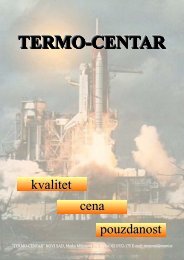SATRONIC - Control boxes for oil burners
SATRONIC - Control boxes for oil burners
SATRONIC - Control boxes for oil burners
You also want an ePaper? Increase the reach of your titles
YUMPU automatically turns print PDFs into web optimized ePapers that Google loves.
APPLICATION NOTES<br />
1. Flame control<br />
The following detectors can be used <strong>for</strong> flame control:<br />
– For yellow <strong>oil</strong> flame: photoresistor MZ 770 S<br />
– <strong>for</strong> blue or yellow flame: infrared-flicker detector type IRD<br />
1010 or as alternative the UV solid state sensor UVD 970.<br />
Using the photo resistor MZ 770 S, the no flame signal is<br />
generated at light levels below 3 Lux with respect to the<br />
operating cycle of the control. According to EN 230 stray<br />
light safety level has to be established in conjunction with<br />
the accompanying burner.<br />
Connecting the IRD 1010 or the UVD 970, the correct wiring<br />
has to be observed.<br />
2. Burner control<br />
With <strong>oil</strong> preheater:<br />
The fuel heater of the burner must have a temperature<br />
control switch. The closing contact-switch of the preheater<br />
has to be connected between terminals 4 and 6. A special<br />
contact in the control unit-connects the thermo-switch of<br />
the heater as soon as the burner is operating and a<br />
photocurrent is generated. There<strong>for</strong>e an interruption of the<br />
burner operation due to a decrease in <strong>oil</strong> temperature is<br />
prevented (e.g. in case of high <strong>oil</strong> flow).<br />
According to EN 230 A2.1, the short circuiting of the thermoswitch<br />
is allowed only <strong>for</strong> an <strong>oil</strong> flow of max. 10 kg/h. Burners<br />
with a higher throughput have to shut down if the <strong>oil</strong><br />
temperature gets below the allowed minimum. In such a<br />
case the thermo-switch has to be put in the phase-circuit<br />
and terminals 4 and 6 have to be connected with a link.<br />
Without <strong>oil</strong> heater:<br />
In such a case the terminals 4 and 6 have to be connected<br />
with a link.<br />
3. Low-voltage protection<br />
The start up of the burner can only take place if the mains<br />
voltage is higher than a limit which is 15% below nominal<br />
value. If the voltage drops below 160V, a start-up is prevented<br />
or – without allowing to release the fuel – the control box<br />
goes into lock out mode.<br />
4. Safety<br />
The design and control sequence of the TF 834.3, TF 834 E.3<br />
and TF836.3 control <strong>boxes</strong> comply with the currently<br />
applicable European standards and regulations.<br />
6. Mounting and electrical wiring<br />
Wiring base:<br />
– 3 earth terminals with additional terminal <strong>for</strong> burner<br />
earthing<br />
– 3 neutral terminals with internal permanent connection to<br />
neutral terminal (terminal 8)<br />
– 2 spare auxiliary terminals<br />
– 2 slide in plates and 2 easy-knockout holes (PG 11<br />
thread), plus 2 easy-knockout holes in the bottom of the<br />
base facilitate the wiring.<br />
General:<br />
– The control box can be mounted in any position. The<br />
protection class is IP44 (water spray tight). Neither the<br />
control box nor the flame detector should be subjected<br />
to excessive vibration.<br />
2<br />
COMMISSIONING AND ROUTINE CHECKS<br />
1. Important notes<br />
– The controls must be installed by qualified personnel<br />
only. The relevant national regulations have to be<br />
observed.<br />
– On commissioning the wiring has to be carefully checked<br />
according the appropriate diagram, Incorrect wiring can<br />
damage the unit and endanger the installation.<br />
– The fuse rating has to ensure that the limits specified in<br />
TECHNICAL DATA will not be exceed. If these precautions<br />
are not observed, the effect of a short circuit can cause<br />
severe damage to the control and installation.<br />
– For safety reasons a minimum of one control shut-down<br />
per 24 hours has to be observed.<br />
– Disconnect the mains be<strong>for</strong>e the control box is plugged<br />
in or out!<br />
– The control box is a safety device and must not be<br />
opened!<br />
2. Function control<br />
For safety reasons the flame detection system should be<br />
tested on commissioning the installation as well as after a<br />
service or longer shut-down.<br />
a) Start-up with covered flame detector<br />
– After lock-out safety time is over the unit has to go in<br />
to lockout mode!<br />
b) Start-up with exposed flame detector:<br />
– After 20 sec. pre-purge time the unit has to go into<br />
lockout mode!<br />
c) Normal start-up with burner in the normal position, cover<br />
up the flame detector:<br />
– After start-up, and end of lock-out safety time the unit<br />
has to go into lockout mode!<br />
3. Fault findings<br />
Burner is not working:<br />
– thermostat circuit open<br />
– faulty electrical wiring<br />
– mains voltage too low<br />
Burner starts, but the flame does not establish, a lock out<br />
occurs:<br />
– stray light on flame detector<br />
– no ignition or no fuel<br />
– mains voltage more than -15% below nominal value.<br />
Burner starts, the flame establishes, but after the safety<br />
time, a lock out occurs:<br />
– dirty or faulty flame detector<br />
– insufficient light on detector<br />
– sensitivity adjustment too low on IRD.<br />
For a quick and safe diagnosis use the Satronic UP 940<br />
burner test box.<br />
TF 834.3/836.3



